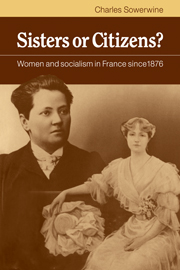Book contents
- Frontmatter
- Contents
- Preface
- Abbreviations of organisations
- Bibliographical abbreviations
- Introduction
- Part I Feminism and socialism 1876–1900
- Part II Origins of the socialist women's movement 1899–1914
- 4 The Groupe Féministe Socialiste 1899–1905
- 5 Women and the SFIO 1905–14
- 6 The Groupe des Femmes Socialistes 1913–14
- Part III Development and decline of the socialist women's movement 1914–79
- Conclusion
- Appendix 1 The Second International and the woman question 1889–1904
- Appendix 2 French socialist women in figures
- Appendix 3 Elisabeth Renaud and the Cambier affair
- Notes
- Bibliography
- Index
5 - Women and the SFIO 1905–14
Published online by Cambridge University Press: 07 October 2011
- Frontmatter
- Contents
- Preface
- Abbreviations of organisations
- Bibliographical abbreviations
- Introduction
- Part I Feminism and socialism 1876–1900
- Part II Origins of the socialist women's movement 1899–1914
- 4 The Groupe Féministe Socialiste 1899–1905
- 5 Women and the SFIO 1905–14
- 6 The Groupe des Femmes Socialistes 1913–14
- Part III Development and decline of the socialist women's movement 1914–79
- Conclusion
- Appendix 1 The Second International and the woman question 1889–1904
- Appendix 2 French socialist women in figures
- Appendix 3 Elisabeth Renaud and the Cambier affair
- Notes
- Bibliography
- Index
Summary
The entire political landscape was transformed by the unification of all the socialist groups into one Parti Socialiste (Section Françhise de l'lnternationale Ouvrière), the SFIO. Whereas in the past socialist women had dealt with small, competing parties, they were now faced with a large, united organisation on its way to becoming one of the four main forces on the political spectrum. In 1906, the SFIO received 878,000 votes and elected fifty-two deputies (of a total of 591); in 1914, 1,398,000 votes and 103 deputies. It was a party of national stature, a far cry from the tiny groups within which Rouzade, Valette, and even the GFS had struggled.
Despite its electoral success, the SFIO did not resolve the problem of mobilisation of militants, always the Achilles' heel of French socialism. (Only the communists would eventually organise a mass party of committed militants and that only in the 1930s, around the Popular Front.) The SFIO began with 34,688 members in 1905 and reached 90,725 in 1914. By that time, the German SPD already had a million members, of whom 175,000 were women.
What would the SFIO do about women? We have already seen that it would not have a women's organisation. It remains to be seen what it would do to attract women individually and to seek women's rights. Would it make use of the national stature it was gaining to work for women's emancipation? And, inversely, what would women do in and about the SFIO?
- Type
- Chapter
- Information
- Sisters or Citizens?Women and Socialism in France since 1876, pp. 108 - 128Publisher: Cambridge University PressPrint publication year: 1982
- 1
- Cited by



